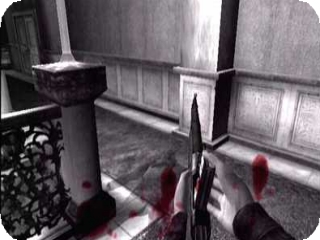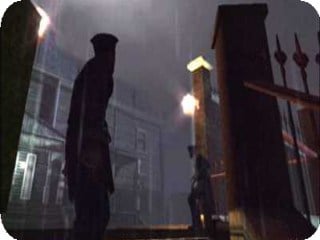Five years is a long time to wait for something. Take for instance the five year wait to get a PlayStation, or the five years to get an Xbox 360. Which brings me to Call of Cthulhu, a game that has been five years in the making, or at least three years and two years of delays. It is a joyous occasion when patience (and much impatience) is rewarded. This is by far the scariest game to be released since Doom 3 and Fatal Frame before it. The mythos of Great Cthulhu comes from the short stories by early twentieth century author H.P. Lovecraft and this game stays true to its source material. The story opens with the main character, Detective Jack Walters sitting in an asylum (Arkham Asylum for us Lovecraft enthusiasts) scribbling frantically on the floor with his blood. The story then unfolds by telling the player how the intrepid detective came to be in such a dismal surrounding. I will not give any specific information on the story so as not to spoil it for players, but the storyline ranges the gamut of Lovecraftian locales. It would almost seam that the creators of this game placed certain scenes and locations as homage to other creators who also enjoy the Cthulhu mythos. For instance, the opening movie would remind one of the opening sequences of John Carpenter’s “In the Mouth of Madness”; and during the formative stages of the game, which takes place in the town of Innsmouth, giving a nod to the movie “Dagon”. The story is accessible for all players to grasp, though the true Lovecraft enthusiast will get the most enjoyment.
Graphically, this game is top-notch, while not quite perfect, it is one of the best looking games to be released on the Xbox. Character sprites are rendered smoothly, with no jagged edges to the silhouettes. Cracked and peeling paint looks molded, cockroaches skitter across frayed carpets, and spider webs ebb and flow gracefully in the breeze, and cut scenes are displayed with a “grainy” effect that would remind one of certain other survival horror games. The game is played in first person perspective, and perhaps one of the most innovative approaches to the genre is the exclusion of HUD (heads-up display) clutter. There is no life bar, no ammunition counter, no inventory reminder, just the environment. To access the player’s health rating or to check ammunition remaining, the player must enter a menu screen which shows a full view of the character and any inventory items. Another inclusion to the game is the method of healing. Should the character get wounded, the player must keep check on him via the status screen. Scrapes and cuts, and even ribs and broken bones will be shown on the character model. The player must then tend to the wounds using various first aid implements, much like Metal Gear Solid 3: Snake Eater.
 While these things are standard for games now and are not very innovative, the greatest innovation to this game is the mental health of the character. The Cthulhu mythos involves the insignificance of man, and the game reflects that by making the character as true-to-life as possible. For instance, the first time the main character spies a dead body, the controller will begin to vibrate rhythmically with Jack’s heart. He may begin labored breathing, he might begin to ramble incessantly, even hear the voices of demons speaking to him; or perhaps his vision becomes blurry, even shaking, all the while the player must continue to play the game, contending with the gaming environments and making sure their character does not lose his marbles and take his own life in a fit of insanity. Other psychological effect will take place, depending on the situation in the game, like a fear of heights, or tense gunfights, with blurring vision due to the high level of stress. This style of game play enhances the experience of Call of Cthulhu, where in this game it is not what is on the other side of the door, it is what might be on the other side, and whether a human mind can comprehend its horrors.
While these things are standard for games now and are not very innovative, the greatest innovation to this game is the mental health of the character. The Cthulhu mythos involves the insignificance of man, and the game reflects that by making the character as true-to-life as possible. For instance, the first time the main character spies a dead body, the controller will begin to vibrate rhythmically with Jack’s heart. He may begin labored breathing, he might begin to ramble incessantly, even hear the voices of demons speaking to him; or perhaps his vision becomes blurry, even shaking, all the while the player must continue to play the game, contending with the gaming environments and making sure their character does not lose his marbles and take his own life in a fit of insanity. Other psychological effect will take place, depending on the situation in the game, like a fear of heights, or tense gunfights, with blurring vision due to the high level of stress. This style of game play enhances the experience of Call of Cthulhu, where in this game it is not what is on the other side of the door, it is what might be on the other side, and whether a human mind can comprehend its horrors.
The controls are very intuitive, with the standard dual analog stick style of movement, the right trigger being the firing button for the gun, and standard “action”, “crouch”, and “aiming” allocated accordingly. The controls can be adjusted for sensitivity, and the only grievance would be that in certain “tense” moments of frantic running, the controls can have a tendency to not be quite precise, but a small glitch in the overall spectrum. The music is haunting, and the sound effects are awesome, evoking the maritime feel of underwater demons and gargantuan horrors.
 This game is not a shooter, and the player should enter it knowing this. It is a first person survival horror game, even comparable to old school point-and-click computer games, with the player needing to search everywhere for valuable story clues and items. Your character will spend much of the game without a gun, having to run for his life more than standing his ground. I will not mislead, either, this game is difficult, seeming nearly impossible at times, and the player should be prepared to die… a lot. Many checkpoints will be reloaded numerous times, but thankfully the saving points are given generously, so no serious backtracking will be required.
This game is not a shooter, and the player should enter it knowing this. It is a first person survival horror game, even comparable to old school point-and-click computer games, with the player needing to search everywhere for valuable story clues and items. Your character will spend much of the game without a gun, having to run for his life more than standing his ground. I will not mislead, either, this game is difficult, seeming nearly impossible at times, and the player should be prepared to die… a lot. Many checkpoints will be reloaded numerous times, but thankfully the saving points are given generously, so no serious backtracking will be required.
While this game will more than likely not appeal to the masses, the Lovecraft fans will adore it, as I did. There are things that could have been done differently, but for my money, this game satisfies, and will continue as it can be replayed for extra content. It is one of the scariest, most intense games available today, so if anyone is looking for a terrifying adventure, this game will deliver. Ia! Ia! Cthulhu fhtagn!
